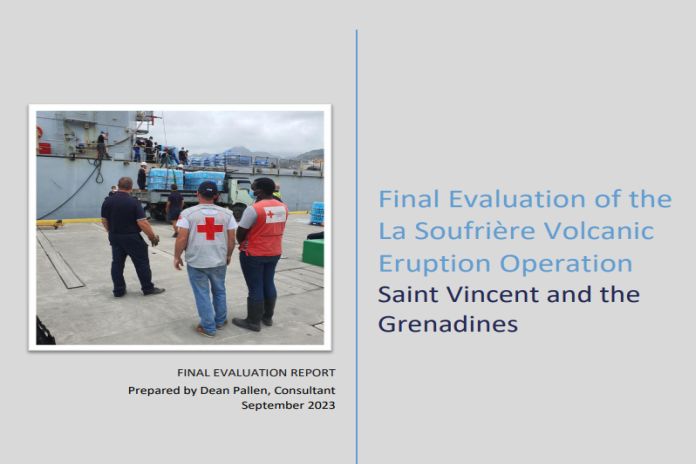KINGSTOWN, St Vincent, (Executive Summary) – In December 2020, the active volcano La Soufrière in St Vincent and the Grenadines (SVG) began to erupt effusively. This was the fifth eruption since 1718. In April of 2021, the government issued evacuation orders as the alert level reached Red. Soon after mandating the evacuation, on 9 April 2021, La Soufrière erupted explosively.
This was followed by successive eruptions that was complicated by a number of serious storms that made efforts to recover from the devastation caused by the eruption even more challenging. The eruption also occurred at a time when the country was in the midst of the COVID-19 pandemic and a significant spike in the number of Dengue fever cases being treated by the ministry of health, wellness and the environment.
Three days after the eruption on the 12 of April 2021, a Disaster Response Emergency Fund (DREF) was approved by the International Federation of the Red Cross (IFRC) for CHF 266,000 to assist 700 families. Subsequently, on 18 April 2021, an Emergency Appeal for CHF 2,000,000 to assist 1,800 families (1,500 families in SVG & 300 families from other affected islands) was launched.
The IFRC and St Vincent and the Grenadines Red Cross Society’s (SVGRC) committed to providing emergency assistance and recovery support to 5,400 people (1,800 families) affected by the La Soufrière volcanic eruption with a specific focus on Shelter and Essential Household Items (EHI), Livelihood & Basic Needs, Psychosocial support (PSS), Protection, Gender & Inclusion (PGI), and Disaster Risk Reduction (DRR). Fortunately, anticipated impacts as a result of the eruption in Barbados, Grenada and Saint Lucia did not occur allowing for the shifting of resources to SVG where they were greatly needed.
According to the National Emergency Management Organisation (NEMO), approximately 24,419 persons from 21 communities were displaced through mandatory evacuation in vulnerable zones surrounding La Soufrière in the island’s northern region. While there was considerable damage to property and land, no deaths were recorded.
In addition to the eruption, heavy rainfall occurred across the mainland island of Saint Vincent, causing lahar mud and debris flows, that compounded the situation in areas already being affected by the eruptions of La Soufrière. According to media reports, several lahar flows were recorded from all surrounding points of the volcano, damaging homes, businesses, and infrastructure. People were impacted across the island through the multiple eruptions over a period of several weeks.
The final evaluation of the emergency appeal of the La Soufrière response was carried out between 3 April 2023 to 30 August 2023. The fieldwork for the evaluation was carried out between 28 May to 4 June 2023. The evaluation assesses the IFRC and SVGRC initial response to the La Soufrière eruption on 9 April 2021 and activities carried out to 31 December 2022.
Specifically, the evaluation assessed the support provided to the impacted population targeted by the Emergency Plan of Action (EPoA) and answers questions related to relevance and appropriateness, efficiency, effectiveness and sustainability. The evaluation also highlights key Lessons Learned to assist the Red Cross in future response and recovery operations with the very particular focus on volcanic eruptions in the Caribbean region.
Final Evaluation of the La Soufrière Volcanic Eruption Operation Saint Vincent and the Grenadines – Final Evaluation_La Soufriere Operation SVG





